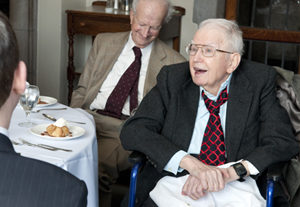Lunch and lore
A 100th-birthday celebration attracts a roomful of UChicago scholars—and UChicago conversation.
By Amy Braverman Puma
Photography by Lloyd DeGrane

Gary Becker saluted Ronald Coase (right) at Coase’s Quad Club lunch.
I took a spot in the back of the Quadrangle Club solarium, leaving room for A-list guests to sit closer to the luncheon’s honoree, Nobel Prize–winning economist Ronald Coase. Yet in the end pretty much everyone who’d come to celebrate Coase’s 100th birthday was A-list, and my out-of-the-way table filled with University notables.
Roger Myerson, a 2007 economics Nobelist, was still pulling in his chair when economist and New York Times columnist Casey Mulligan shot a question across the table: “Roger, do you think we should be in Libya?” From his perspective, Myerson responded, Arab League and UN approval for the no-fly zone made it a justifiable intervention.
Meanwhile, economist Allen Sanderson was delighted to be sitting next to University Provost Thomas Rosenbaum, he told the quantum physicist, because he had a burning question—about the physics of kids’ soccer. “At my granddaughter’s games,” Sanderson said, “whenever the goalie gets the ball, she throws it. Wouldn’t kicking be better?” Yes, Rosenbaum agreed: legs are stronger than arms, so kicking, although less accurate, would get the ball farther down the field.
Toward the end of the lunch, economics department chair Harald Uhlig and then economist Gary Becker, AM’53, PhD’55, a Nobelist himself, got up to speak about Coase, who had turned 100 this past December. Becker told the room how Coase had been born in England, attended the London School of Economics, and in 1950 came to the United States, first to the East Coast but in 1964 settling at the University of Chicago Law School—“the first law school,” Becker believes, “that had an economist teaching full time.” Law School professor Aaron Director had started the Journal of Law and Economics in 1958, and after Director retired in 1965, Coase “really made it into a major and influential journal.” When Becker first met him in 1970, Coase “didn’t say a lot, but I began to realize that every time he did say something, it was really profound.”
Becker discussed Coase’s “four most important papers,” including his 1937 article “The Nature of the Firm” and 1960’s “The Problem of Social Cost,” which was cited when Coase won the 1991 Nobel. When that paper, about bargaining, social costs, and efficiency, was published, Becker said, “I read it, and it seemed revolutionary. I called [George] Stigler [PhD’38] and said, ‘This seems like an important paper.’ George said, ‘Yes, but a lot of people around here don’t think it’s correct.’ I read it again. It seemed correct to me. I assigned it to my class.” The paper laid out what’s known as the Coase Theorem, which is so often misunderstood that there is an academic paper (PDF) about whether economists teach it correctly.
Coase retired from the Law School in 1984 but is “still working,” Becker said. He and Arizona State assistant professor Ning Wang, AM’96, PhD’02, have coauthored How China Became Capitalist (Palgrave Macmillan), due out in August.
After the meal, Sanderson remarked that it had been “an intimate lunch with four Nobel Prize winners.” Along with Coase, Becker, and Myerson, 1995 laureate and Chicago professor Robert Lucas, AB’59, PhD’64, was also at the gathering. And it was intimate indeed: afterward I felt I knew some of them myself.
